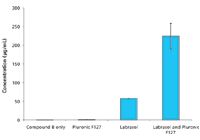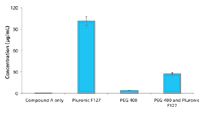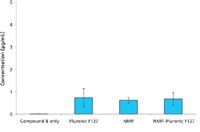Inhibiting the Precipitation of Poorly Water-Soluble Drugs from Labrasol Formulations
The study results suggested that Pluronic F127 might be a potent inhibitor of drug precipitation for Labrasol formulations.
About 40% of compounds identified through high-throughput or combinatorial screening approaches are poorly water soluble (1–3). They are usually difficult to formulate and often exhibit a low oral bioavailability, which may result in delays in development or cause them to be dropped from the pipeline (4). Scientists have developed and proposed various formulation techniques to improve the solubility and bioavailability of poorly water-soluble compounds (5). One of the most common techniques entails using various solubilizing agents, including surfactants. Gattefossé's Labrasol (saturated polyglycolyzed C8 -C10 glyceride) surfactant is widely used as a powerful agent for increasing the solubility and bioavailability of low-solubility drugs (6).
However, despite its high solubilizing capacity, Labrasol cannot keep drugs solublized when a neat drug–Labrasol formulation is diluted with an aqueous medium. Drugs often precipitate out of the formulation after dilution, thus causing low bioavailability (7, 8). Such precipitation in vivo may reduce drug concentration needed in the aqueous phase for immediate action, thus resulting in a delayed or reduced efficacy (9, 10). Drug precipitation in vivo is a predominant cause of low oral bioavailability for poorly water-soluble compounds (11).
Formulators have made significant efforts to inhibit or reduce drug precipitation from Labrasol formulations. One common approach is to mix Labrasol with pharmaceutical excipients, such as hydrophobic oils, lipids, surfactants, and cosolvents, to form microemulsions or emulsion systems (12–15). Drugs can be held tightly in the more hydrophobic cores of the emulsion systems than in Labrasol alone upon dilution. This characteristic inhibits drug precipitation. Despite a significant improvement in inhibiting drug precipitation, these Labrasol formulations are usually complicated and involve multiple components. The formulations also may raise concerns about drug loading, scale-up, and cost.
The aim of this study was to inhibit drug precipitation from Labrasol formulations by identifying and incorporating a precipitation inhibitor into them. Two of Johnson and Johnson's poorly water-soluble compounds were selected as model compounds. Pluronic F127 was identified and added as a precipitation inhibitor into Labrasol formulations. Compound precipitation from Labrasol formulations with or without Pluronic F127 was assessed by a parallel microscreening precipitation method using 96-well plates and a Tecan robot.
Materials and methods
Compounds. Two poorly water-soluble compounds (Compounds A and B) were obtained from the Johnson and Johnson Pharmaceutical Research and Development compound collection. The molecular weights of Compound A and B were 425.51 g/mol and 676.77 g/mol, respectively. Compound A had aqueous solubility of 1 μg/mL at neutral pH, and the solubility of Compound B was < 0.2 μg/mL at pH 7.4. Both compounds were thus typical of Biopharmaceutics Classification System Class II compounds. One of the factors that led to the poor oral bioavailability of both compounds was their low aqueous solubility.
Formulation excipients and biorelevant media. Pluronic F127 and Labrasol were obtained from BASF and Gattefossé, respectively. Polyethylene glycol (PEG) 400, 1-methyl-2-pyrrolidinone (NMP), and pyrene were purchased from Sigma-Aldrich. Simulated intestine fluid (SIF) (pH 7.4) was prepared according to the US Pharmacopeia, but no enzymes were added.
In vitro precipitation method. The in vitro drug precipitation upon dilution in an aqueous medium was assessed as described in the literature (10, 16, 17). The stock solutions of the tested compounds and the excipients, including Labrasol, were first prepared in n-propanol at concentrations of 5 and 20 mg/mL, respectively. Then, according to formulation design, the compounds and each excipient solution at various volume ratios were automatically dispensed into each well of a 96-well microtiter plate (Scienceware, Bel-Art Products) by a Tecan robot (GENESIS Workstation). After vortexing for homogeneous mixing, the microtiter was then placed in a centrifugal vacuum evaporator (HT-4X, GeneVac) and run for 2 h to remove n-propanol from the plates. After solvent removal, 120 μL of SIF was added to each well of the plate. Following 24-h incubation at room temperature, aqueous solution was filtered through a 0.2-μm 96-well polyvinylidene fluoride (PVDF) filter plate, and drug aqueous concentration in the filtrates was determined using high-performance liquid chromatography (HPLC).
HPLC method. An HP1100 HPLC instrument with an autosampler module for a 96-well microtiter plate (Agilent) was used to analyze compound concentration. In the HPLC assay for Compound A, a C18 column (50 × 4.6 mm, 2.5 μm, Thermo BDS hypersil, 35 °C) and a mobile phase containing 40% acetonitrile and 60% ammonium formate buffer (pH 3.3) (by volume) were used. The flow rate was controlled at 1 mL/min with an injection volume of 20 μL. The effluent was detected for the compound concentration at a wavelength of 270 nm. The run time was 4 min per sample. In the HPLC assay for Compound B, 20 μL of the sample were injected into a Waters Xterra RP18 column (150 mm × 4.6 mm, 3.5 μm) (Waters). The sample was eluted at 30 °C at 1 mL/min by a mobile phase consisting of 70% (v/v) acetonitrile with 0.1% trifluoroacetic acid (TFA) and 30% (v/v) water with 0.1% TFA. Compound B's concentration was measured at an ultraviolet wavelength of 245 nm. The retention time of the compound was 2.5 min during a total 4.25-min run time per sample. None of the excipients used in the study interfered with both assays.
Compound solubility in neat excipients. The solubility of Compounds A and B in neat excipients, such as Labrasol, PEG 400, and NMP, was determined by a shake-flask method. Excess compound solids were suspended in 1 mL of tested excipients, and the suspensions were shaken at 37 °C for two to five days. Aliquots were withdrawn and filtered through a 0.2-μm PVDF filter. The filtrate was diluted with acetonitrile, and the compound concentration in the filtrate was analyzed by a corresponding HPLC method. Equilibrium solubility was determined when the concentration of the compound in the suspension did not increase further with incubation time.
Pyrene vibrational emission measurement. The authors prepared 2-mg/mL solutions of Labrasol, Pluronic F127, and the mixture of Pluronic F127 and Labrasol by dissolving the appropriate amount of substances in SIF. Pyrene solution (0.05 mg/mL) was prepared in acetone. Subsequently, 10 μL of pyrene solution was added to the appropriate volume of Labrasol, Pluronic F127, and their mixture to achieve a final pyrene concentration of 6 × 10–7 M. Samples were incubated at 37 °C in a shaker for 1 h, followed by an overnight shaking at room temperature. Fluorescence excitation spectra of pyrene were obtained using a Hitachi F-4500 fluorescence spectrophotometer. The vibrational-emission spectrum of pyrene comprising the formulations from 350 to 400 nm was measured at an excitation wavelength of 340 nm. The excitation and emission-band slits were 4 and 2 nm, respectively. The intensity ratio of I333/I338 was calculated.
Results
Compounds A and B were soluble in Labrasol at 29.6 and 34 mg/mL, respectively (see Table I). However, both compounds precipitated out of the Labrasol formulations significantly when the Labrasol neat formulations were diluted in aqueous media. For example, 73% of Compound A precipitated out when the Labrasol formulation was diluted in SIF under the tested condition. The compound concentration upon dilution decreased to 224.5 μg/mL at the loading of 833 μg/mL of Compound A (see Figure 1). The results indicated that Labrasol could keep only 27% of Compound A soluble in the medium.

Table I: Compound solubility in Labrasol and the concentration upon dilution with simulated intestine fluid.
In sharp contrast, after the addition of Pluronic F127 into the Labrasol formulation (Pluronic F127:Labrasol = 1:5, w/w), more than 64% of compound A remained solubilized upon dilution. Compound concentration upon dilution reached 537.1 μg/mL, compared with 1 μg/mL without any excipients. This increased concentration prompted by Pluronic F127 and Labrasol was much higher than that resulting from Pluronic F127 (101.1 μg/mL) or Labrasol (224.5 μg/mL) alone. The increase was also statistically significantly higher than the sum of the compound concentrations in the individual and Pluronic formulations (p < 0.001). The results suggested that a combination of Pluronic F127 and Labrasol resulted in a synergistic effect on inhibiting compound precipitation under the tested conditions.

Figure 1: Compound A concentration upon dilution of Labrasol formulations with simulated intestine fluid (n = 3). (all figures are courtesy of the authors)
This synergistic effect was also demonstrated with Compound B. When Labrasol neat formulation was diluted with SIF, 88.5% of Compound B precipitated despite a good compound solubility (i.e., 34 mg/mL) in Labrasol neat formulation. Similar to the findings observed in the Compound A study, the addition of Pluronic F127 into the Labrasol formulation achieved a concentration of 224.11 μg/mL in SIF, which was significantly higher than concentrations in Labrasol (i.e., 57.7 μg/mL) or Pluronic F127 (0.73 μg/mL) alone, and higher than the sum of the individual compound concentrations in Labrasol and Pluronic formulations (p < 0.001) (see Figure 2).

Figure 2: Compound B concentration upon dilution of Labrasol formulations with simulated intestine fluid (n = 3).
In addition to Labrasol, the authors investigated whether Pluronic F127 inhibited drug precipitation out of the formulations containing PEG 400 or NMP. Compound A had good solubility in PEG 400 (i.e., 53.8 mg/mL). However, most of the compound precipitated quickly out of the PEG 400 formulation upon dilution in SIF. Interestingly, unlike the results with Labrasol, the addition of Pluronic F127 into the Compound A–PEG 400 formulation only inhibited precipitation to a limited extent compared with the PEG control (see Figure 3). Compound A's concentration upon dilution with the Pluronic F127–PEG 400 combination was 27.0 μg/mL. The concentration was significantly higher than that in the PEG 400 formulation (i.e., 4.1 μg/mL), but lower than that in the Pluronic F127 formulation (i.e., 101.1 μg/mL). The result suggested an absence of inhibitory synergy between Pluronic F127 and PEG 400. Similarly, no synergistic inhibition effect on the precipitation of Compound B was observed when Pluronic F127 was combined with the NMP formulation. Almost all compounds precipitated in all formulations (see Figure 4).

Figure 3: The inhibitory effect of Pluronic 127 on precipitation of compound A in Labrasolâpolyethylene glycol (PEG) 400 formulations (n = 3).
To understand the inhibitory mechanism of Pluronic F127 in the Labrasol formulation, the micropolarity of the Labrasol formulation with or without Pluronic F127 was characterized by the ratio of band I to band III (i.e., I333/I338) in a vibrational emission spectrum of pyrene. As shown in Table II, the I333/I338 value of the Pluronic F127–Labrasol mixture was significantly lower than that of Pluronic F127 or Labrasol alone (p < 0.02).

Figure 4: The inhibitory effect of Pluronic 127 on precipitation of compound A in Labrasolâ1-methyl-2-pyrrolidinone (NMP) formulations (n = 3).
Discussion
This study focused on identifying a precipitation inhibitor that could inhibit or reduce drug precipitation from Labrasol formulations. Pluronic F127 was a potent agent for inhibiting precipitation of the tested compounds out of Labrasol formulations. Combinations of Pluronic F127 with Labrasol inhibited drug precipitation to a greater extent than Pluronic F127 did alone. This synergistic inhibitory effect was demonstrated with two poorly water-soluble compounds. In place of the complicated, multiple-component emulsion systems reported in the literature, Pluronic F127 can be added as the precipitation inhibitor and mixed with Labrasol. The Pluronic F127–Labrasol formulation is simple, easy to process and manufacture, and has advantages for scale-up and cost because it uses existing formulation processes and commercially available facilities. Adding Pluronic F127 into Labrasol formulations can improve them by inhibiting drug precipitation upon dilution.
Pyrene was used to explore the underlying mechanism for inhibiting drug precipitation by Pluronic F127 in Labrasol formulations in this study. Pyrene has been widely used to probe the microenvironment of particles, such as micelles, microparticles, nanoparticles, and proteins. The I333/I338 ratio in the vibrational emission spectrum of pyrene indicated the particles' micropolarity. Low I333/I338 values represent more hydrophobic microenvironments than higher values do (18–20). The pyrene study results suggested that adding Pluronic F127 into Labrasol reduced the I1/I3 value significantly (see Table II), thus indicating the formation of an increasingly hydrophobic microenvironment. The increasingly hydrophobic microenvironment could be attributed to hydrophobic interaction between surfactants or to the hydrogen binding observed in other mixed micelles (18, 21, 22). This increasingly hydrophobic microenvironment enhances the hydrophobic interaction of drugs with hydrophobic cores of mixed surfactants, as reported previously (23, 24). The microenvironment therefore holds the drug more tightly and inhibits drug precipitation upon dilution. In contrast, when Pluronic F127 was added into PEG 400 or NMP, the I333/I338 value of these mixtures did not decrease (see Table 2). No hydrophobic microenvironment was formed because PEG 400 and NMP are highly hydrophilic solvents.

Table II: I333/I338 value of the vibrational-emission spectrum of pyrene.
The results agreed with previous findings that the selected surfactant mixtures can result in more hydrophobic cores than individual mixtures (18, 20, 22, 25, 26). The synergistic results of Pluronic F127 with Labrasol in this study were also consistent with an increasingly hydrophobic microenvironment when Pluronic F127 was mixed with other surfactants. For example, the mixture of Pluronic F127 with D-alpha-tocopheryl polyethylene glycol 1000 succinate (vitamin E TPGS) became more hydrophobic than Pluronic F127 or Vitamin E TPGS alone. Corresponding to this enhanced hydrophobicity, the mixture of Pluronic F127 and Vitamin E TPGS inhibited drug precipitation more than either individual component in a strongly synergistic effect (27).
If Pluronic F127 is combined with micelle-forming surfactants, it will interact with the surfactants, which increases the hydrophobicity of the mixed micelles, and thus strongly inhibits drug precipitation, as observed in the mixture of Pluronic F127 with Labrasol or Vitamin E TPGS (see Figure 4) (27). More studies are needed to further confirm this hypothesis using a large number of drugs and various surfactants. In addition to testing combinations of Pluronic F127 with various surfactants, it would be interesting to investigate how types and amounts of Pluronics affect the inhibition of drug precipitation. In the case of the Pluronic and Vitamin E TPGS mixture, Pluronic F127 and Pluronic F108, but not Pluronic F68, inhibited the compound precipitation in SIF. Pluronic F127 was the most potent drug-precipitation inhibitor (27). It would be interesting to analyze whether this finding proves true for other surfactants.
Conclusion
The addition of Pluronic F127 into the Labrasol formulations inhibited the precipitation of the tested compound upon dilution, and a synergistic effect on inhibiting drug precipitation was observed. The study results suggest that Pluronic F127 could be a potent inhibitor of drug precipitation for Labrasol formulations.
Wei-Guo Dai* is a fellow at Johnson & Johnson Pharmaceutical Research and Development, 145 King of Prussia Rd., Radnor, PA 19087. Liang C. Dong is chief scientific officer at ADDS Pharmaceuticals, and Abla A. Creasey is executive director of advanced technologies and regenerative medicine at Johnson & Johnson.
*To whom all correspondence should be addressed.
Submitted: Dec. 10, 2010. Accepted: Feb. 3, 2011.
References
1. R. Lipper, Modern Drug Discov. 2 (1), 255–260 (1999).
2. C.A. Lipinski, American Pharm. Rev. (Fall), 582–585 (2002).
3. C.A. Lipinski, J. Pharmacol. Toxicol. Methods 44 (1), 235–249 (2001).
4. R.A. Prentis, Y. Lis, and S.R. Walker, Br. J. Clin. Pharmacol. 25 (3), 387–396 (1988).
5. S.H. Yalkowsky, Solubility and Solubilization in Aqueous Media, S.H. Yalkowsky, Ed. (Oxford Univeristy Press, New York, 2000).
6. R.G. Strickley, Pharm. Res. 21 (2), 201–230 (2004).
7. P.C. Sheen et al., Int. J. Pharm. 118 (2), 221–227 (1995).
8. S. Fernandez et al., Pharm. Res. 26 (8), 1901–1910 (2009).
9. W.G. Dai, Int. J. Pharm. 393 (1–2), 1–16 (2010).
10. W.G. Dai et al., J. Pharm. Sci. 96 (11), 2957–2969 (2007).
11. B.A. Hoener and L.Z. Benet, "Factors Influencing Drug Absorption and Drug Availability," in Drugs and the Pharmaceutical Sciences, G.S. Banker and C. Rhodes, Eds. (Informa Healthcare, New York, 4th ed., 2002), pp. 93–117.
12. S. Barakat Nahla, J. Pharm. Pharmacol. 62 (2), 173–180 (2010).
13. T.R. Kommuru et al., Int. J. Pharm. 212 (2), 233–246 (2001).
14. H.J. Kim et al, Drug Dev. Ind. Pharm. 26 (5), 523–529 (2000).
15. G. Venkatesh et al., Drug Dev. Ind. Pharm. 36 (6), 735–745 (2010).
16. W.G. Dai et al., Int. J. Pharm. 336 (1), 1–11 (2007).
17. W.G. Dai et al., Adv. Drug Deliv. Rev. 60 (6), 657–672 (2008).
18. A.R. Das et al., J. Surf. Sci. Technol. 14 (1–4), 41–47 (1998).
19. M.G. Neumann, C.C. Schmitt, and E.T. Iamazaki, Carbohydr. Res. 338 (10), 1109–1113 (2003).
20. T. Yoshimura, A. Ohno, and K. Esumi, J. Colloid Interface Sci. 272 (1), 191–196 (2004).
21. V.A.d.O. Tiera, M.J. Tiera, and M.G. Neumann, J. Dispers. Sci. Technol. 22 (2 & 3), 177–184 (2001).
22. M.S. Bakshi et al., J. Colloid Interface Sci. 286 (1), 369–377 (2005).
23. P.A. Bhat, G.M. Rather, and A.A. Dar, J. Phys. Chem. B 113 (4), 997–1006 (2009).
24. L.S.C. Wan and P.F.S. Lee, Can. J. Pharm. Sci. 10 (3), 69–73 (1975).
25. M.S. Bakshi and K. Singh, J. Colloid Interface Sci. 287 (1), 288–297 (2005).
26. M.S. Bakshi et al., Colloids Surf. A Physicochem. Eng. Asp. 278 (1–3), 129–139 (2006).
27. W.G. Dai et al., Int. J. Pharm. 355 (1–2), 31–37 (2008).
Citation: When referring to this article, please cite it as "W.G. Dai, L.C. Dong, and A.A. Creasey, "Inhibiting the Precipitation of Poorly Water Soluble Drugs from Labrasol Formulations," Pharmaceutical Technology 35 (6) 50-54(2011)."

Pharmaceutical Tariffs Are Imminent: How Industry is Bracing for Impact
April 16th 2025On April 14, 2025, the Trump Administration launched a national security-driven investigation into pharmaceuticals, a move that will likely result in tariffs being placed on pharmaceutical drugs, ingredients, and other components that are imported from outside of the United States.
Drug Solutions Podcast: A Closer Look at mRNA in Oncology and Vaccines
April 30th 2024In this episode fo the Drug Solutions Podcast, etherna’s vice-president of Technology and Innovation, Stefaan De Koker, discusses the merits and challenges of using mRNA as the foundation for therapeutics in oncology as well as for vaccines.